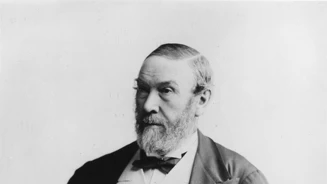Who is the man behind the creation of the Palace of Monserrate?
26 Jan 2023

The Palace of Monserrate looks like something taken straight out of a film. No-one can be indifferent to its imposing façade and three red domes, which stand out against the northern slope of the Sintra hills. But who was the man who imagined this idyllic setting?
His name was Francis Cook. He was born on 23 January 1817 in London. His father was the owner of one of the largest cloth and clothing manufacturing firms in the UK. It was in this company that Francis began his career as a merchant. By 1869, he was already the third richest man in the UK.
Cook used the money he had accumulated over the decades to buy unique pieces, thus creating a rich collection of art. This English businessman also sought to invest part of his fortune in his refuge in Portugal. Monserrate was the property he chose for this purpose.
The history of this monument dates back to 1540, when Friar Gaspar Preto had a chapel dedicated to Our Lady of Monserrate built here. At the time, the property was in the hands of the Hospital de Todos os Santos (or All Saints Hospital), of which Friar Gaspar was the rector. The property was then passed on to the Mello e Castro family in the 17th century. The Lisbon earthquake of 1755 devastated the site, but the property was nevertheless leased to Gerard de Visme, an English merchant who had a neo-Gothic-style castle built here. Shortly afterwards, the writer William Beckford became Monserrate's new tenant. The site was eventually abandoned, but continued to attract the attention of many well-known figures, including Lord Byron, who expressed his love for Monserrate in the poem "Childe Harold's Pilgrimage".
It was in 1846 that Francis Cook decided to acquire this property full of stories to tell and build his little refuge. Taking advantage of the floor plan of the original building, he had a palace built that was very different from anything that existed in Portugal at the time. Its Gothic, Indian and Moorish influences and exotic plant motifs make this palace a unique monument, surrounded by a botanical garden that allows us to travel through time and space. Indeed, the Park of Monserrate hosts species from all over the world, which have been organised by geographical area. It was here that the Cook family spent their holidays and organised large parties. In the neighbourhood around the estate, "the Viscount", as he was known after receiving the title of Viscount of Monserrate, was seen as a good man who employed the residents of the village of Galamares and the surrounding area, giving them land to prosper.
Francis Cook died on 17 February 1901 in London. The Portuguese government acquired the property and the palace in 1949 before, a few years later, the Park and Palace of Monserrate were classified as a Property in the Public Interest. They form a key part of the Cultural Landscape of Sintra ranked by UNESCO as World Heritage in 1995.
